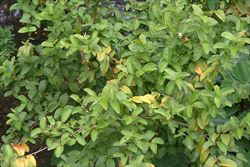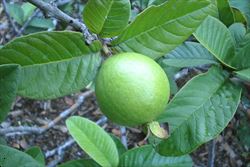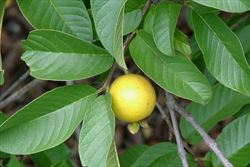Click on images to enlarge

habit (Photo: Sheldon Navie)

habit (Photo: Sheldon Navie)

bark on main trunk (Photo: Sheldon Navie)

paired leaves with numerous prominent veins (Photo: Sheldon Navie)

young leaves (Photo: Sheldon Navie)

older stem and leaf undersides (Photo: Sheldon Navie)

four-sided younger stems and flower buds (Photo: Sheldon Navie)

white flowers borne singly in the upper leaf forks (Photo: Sheldon Navie)

close-up of flowers with numerous stamens (Photo: Sheldon Navie)

immature fruit (Photo: Sheldon Navie)

mature fruit (Photo: Sheldon Navie)

close-up of seeds (Photo: Steve Hurst at USDA PLANTS Database)

seedling (Photo: Sheldon Navie)
Scientific Name
Psidium guajava L.
Family
Myrtaceae
Common Names
apple guava, Brazilian guava, common guava, guava, Guinea guava, lemon guava, pear guava, tropical guava, yellow guava
Origin
This species has been cultivated for a long period of time, therefore its exact native range is somewhat obscure. However, it is thought to be native to Mexico, Central America, the Caribbean and tropical South America (i.e. French Guiana, Guyana, Surinam, Venezuela, south-eastern Brazil, Bolivia, Colombia, Ecuador, Peru, Paraguay and northern Argentina).
Cultivation
Guava (Psidium guajava) is widely cultivated as a fruit tree and garden ornamental in the warmer parts of Australia.
Naturalised Distribution
Guava (Psidium guajava) is widely naturalised in the coastal districts of Queensland and northern New South Wales. It is also naturalised on Lord Howe Island, Norfolk Island and Christmas Island.
Also widely naturalised in other parts of the world including south-eastern USA (i.e. Florida and Louisiana), Oceania (i.e. Hawaii, American Samoa, Western Samoa, Tonga, the Solomon Islands, Niue, Palau, the Cook Islands, the Galapagos Islands, Fiji, Guam, French Polynesia, Nauru and New Caledonia), south-eastern Asia (e.g. the Philippines, Taiwan, Cambodia, Malaysia and Papua New Guines), the Mascarenes (i.e. La Réunion and Rodrigues) and southern Africa (i.e. Tanzania, South Africa and Zimbabwe).
Habitat
A widely cultivated species that has become naturalised in the wetter parts of tropical and sub-tropical Australia. It is a weed of waterways, pastures, open and closed forests, forestry plantings, plantation crops, roadsides, disturbed sites and waste areas.
Habit
A shrub or small tree usually growing 1-6 m tall, but occasionally reaching up to 10 m in height.
Distinguishing Features
-
a shrub or small tree with reddish-brown bark that peels off in flakes.
-
its younger stems are four-angled and somewhat hairy.
-
its oppositely arranged leaves (7-15 cm long and 3-6.5 cm wide) have 10-20 pairs of prominent side veins.
-
its white flowers (about 25 mm across) are usually borne singly in the upper leaf forks and have large numbers of stamens.
-
its rounded to pear-shaped fruit (2.5-10 cm long) is yellow and crowned with the remains of the persistent sepals.
Stems and Leaves
The older stems are covered in a smooth, light reddish-brown, bark that peels off in flakes. This sometimes gives the trunks a mottled appearance, because the newly revealed bark is somewhat greenish-brown in colour. Younger stems are greenish in colour, hairy (i.e. pubescent), and somewhat four-angled (i.e. quadrangular).
The simple leaves are oppositely arranged along the stems and are borne on short stalks (i.e. petioles) 4-10 mm long. The leaf blades (7-15 cm long and 3-7 cm wide) are somewhat oval in shape (i.e. ovate-elliptic or oblong-elliptic) with rounded or pointed tips (i.e. obtuse or acute apices) and rounded (i.e. obtuse) bases. They have hairy (i.e. pubescent) undersides (especially when young), entire margins, and are generally dull green in colour. Each leaf has a prominent central vein (i.e. midrib) and 10-20 pairs of side veins (i.e. lateral veins) that are also relatively obvious.
Flowers and Fruit
The flowers are usually borne singly in the upper leaf forks (i.e. axils). These flowers are relatively large (about 25 mm aross) and are borne on a hairy stalk (i.e. pubescent peduncle) 1-2.5 cm long. Each flower has four or five green sepals (6-15 mm long) that are fused together at the base and four or five white petals (10-20 mm long). They also have large numbers (200-250) of small white stamens (6-10 mm long) and a style (6-12 mm long) topped with a stigma. Flowering occurs mostly during spring and summer (i.e. from September to February).
The fruit is either rounded (i.e. globose), egg-shaped (i.e. ovoid) or pear-shaped (i.e. pyriform) and turns from green to yellowish in colour as it matures. These berries (2.5-10 cm long) are crowned with the remains of the persistent sepals (i.e. calyx lobes) and have a juicy pink, white or yellowish coloured pulp containing numerous seeds. The seeds are yellowish in colour and kidney-shaped (i.e. reniform).
Reproduction and Dispersal
This species reproduces mainly by seed, but it can also reshoot from stumps and produce suckers from damaged roots. The seeds are mainly dispersed by fruit-eating (i.e. frugivorous) birds and bats, as well as other animals (e.g. rats and feral pigs).
Environmental Impact
Guava (Psidium guajava) is regarded as an environmental weed in New South Wales, Queensland and on Christmans Island. It is also a potential environmental weed or "sleeper weed" in other parts of Australia, and is listed in the Global Invasive Species Database (GISD).
Legislation
Not declared or considered noxious by any state government authorities.
Management
For information on the management of this species see the following resources:
- the Biosecurity Queensland Fact Sheet on this species, which is available online at http://www.dpi.qld.gov.au.
Similar Species
Guava (Psidium guajava) may be confused with Brazilian guava (Psidium guineense) and Cherry guava (Psidium cattleianum). These species can be distinguished by the following differences:
- guava (Psidium guajava) has hairy (i.e. pubescent) younger stems that are four-angled in cross-section (i.e. quadrangular) and relatively large yellow fruit (2.5-10 cm long). Its flowers are usually borne singly (occasionally in threes) in the leaf forks (i.e. axils) and its somewhat hairy (i.e. pubescent) dull green leaves have 10-20 pairs of prominent side veins (i.e. lateral veins).
- Brazilian guava (Psidium guineense) has hairy (i.e. pubescent) younger stems that are almost rounded in cross-section (i.e. sub-cylindrical) and relatively small yellow fruit (1-2.5 cm long). Its flowers are usually borne in threes (occasionally singly) in the leaf forks (i.e. axils) and its hairy (i.e. pubescent) dull green leaves have 6-10 pairs of side veins (i.e. lateral veins).
- cherry guava (Psidium cattleianum) has hairless (i.e. glabrous) younger stems that are rounded in cross-section (i.e. cylindrical) and relatively small purplish-red or yellow fruit (2-4 cm long). Its flowers are borne singly in the leaf forks (i.e. axils) and its hairless (i.e. glabrous) glossy green leaves have 6 or 7 pairs of side veins (i.e. lateral veins).

